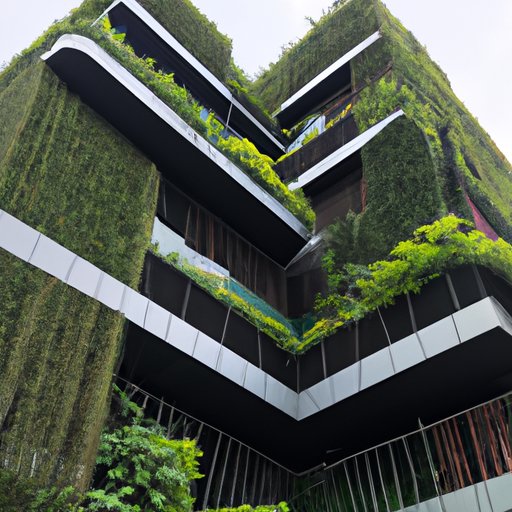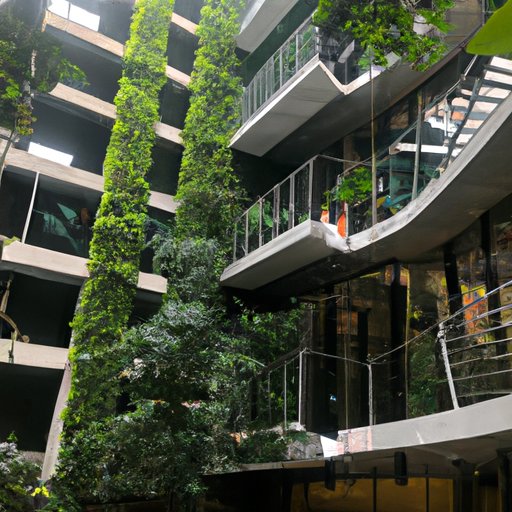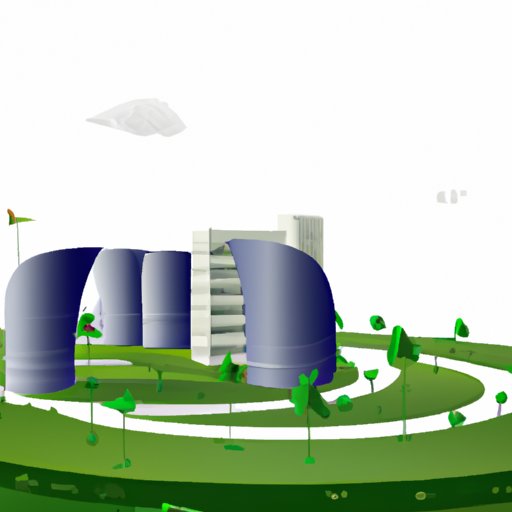Introduction
Green architecture, also known as sustainable design, is an approach to designing and constructing buildings that are more environmentally friendly. This type of architecture is focused on reducing the negative impact of buildings on the environment, using resources efficiently, and creating healthy living environments for people. By implementing green architecture, builders and architects are able to reduce energy consumption, improve air quality, and create more sustainable communities.

Definition and Benefits of Green Architecture
The concept of green architecture has been around since the 1970s when the environmental movement first started gaining traction. It has evolved over the years and now includes a wide range of principles and practices that aim to reduce the environmental impacts of buildings. These include the use of renewable energy sources, efficient water management systems, recycled materials, and natural ventilation. The overall goal is to create structures that are not only more energy-efficient but also healthier for the people who inhabit them.
The benefits of green architecture are numerous. For example, it can reduce energy costs by up to 75%, according to a study conducted by the U.S. Department of Energy. Additionally, green buildings can improve air quality by reducing emissions from heating and cooling systems, enhance occupant comfort by providing natural light and ventilation, and increase property values. Finally, green architecture can help reduce waste and pollution, which in turn can lead to healthier ecosystems and improved public health.
Overview of History of Green Architecture
The history of green architecture goes back centuries. In ancient times, many cultures used simple techniques like passive solar design to keep their homes cool in hot climates. During the Industrial Revolution, the focus shifted towards maximizing efficiency and minimizing cost, often at the expense of the environment. In the 1970s, the environmental movement began to gain traction and green architecture began to emerge as a way of balancing efficiency with sustainability.
Since then, green architecture has continued to evolve. Governments around the world have implemented policies and regulations to encourage the use of sustainable design principles. New technologies such as solar panels, wind turbines, and geothermal systems have become more accessible and affordable. And designers and architects have continued to push the boundaries of what is possible with green architecture.
Types of Green Architecture
There are several different types of green architecture, each with its own unique set of benefits. Here are some of the most common:
Passive Solar Design
Passive solar design takes advantage of the sun’s natural energy to heat and cool a building. This is done by orienting the building to maximize the amount of sunlight it receives during the day, while minimizing the amount of heat loss at night. This can be achieved through the use of shading devices, insulated windows, and other strategies. According to a study conducted by Lawrence Berkeley National Laboratory, passive solar design can reduce energy costs by up to 50%.
Sustainable Building Materials
Sustainable building materials are materials that are either recycled or produced in an environmentally friendly manner. Examples include bamboo, recycled steel, and composite wood. Using sustainable materials can reduce the amount of energy and resources needed to produce and transport them, as well as reduce waste. Furthermore, these materials often require less maintenance, which can further reduce costs.
Green Roofs and Walls
Green roofs and walls are another type of green architecture. These are roofs and walls that are covered in vegetation, which helps reduce stormwater runoff, absorb pollutants, and regulate temperature. Green roofs and walls can also provide habitat for wildlife and improve air quality. According to the EPA, green roofs can reduce energy costs by up to 25%.

Examples of Green Architecture Projects
Green architecture is being used in a variety of projects around the world. Here are a few examples:
The Eden Project
The Eden Project is a botanical garden located in Cornwall, England. The project was designed to be as sustainable as possible and uses a number of green architecture principles. These include passive solar design, green roofs, and rainwater harvesting. The project has been praised for its innovative design and has become a popular tourist destination.
The Bullitt Center
The Bullitt Center is a six-story office building located in Seattle, Washington. Designed to be “the greenest commercial building in the world”, the Bullitt Center uses a number of green architecture techniques such as a green roof, solar panels, and efficient lighting. The building is expected to be net zero energy by 2020.
The Empire State Building Retrofit
The Empire State Building is one of the most iconic buildings in the world. In 2009, the building underwent a major retrofit that included the installation of energy-efficient lighting, insulation, and windows. As a result, the building has seen a 38% reduction in energy use and an estimated $4.4 million in annual savings.

Challenges of Implementing Green Architecture
Despite the many benefits of green architecture, there are still some challenges that need to be addressed. These include:
Cost
One of the biggest challenges of implementing green architecture is the cost. Sustainable materials, technologies, and designs tend to be more expensive than traditional ones. Additionally, green buildings may require additional permits and inspections, which can also add to the cost. While there are government incentives available to help offset some of the costs, they may not be enough to make green architecture a viable option for all projects.
Change in Building Regulations
Another challenge is the lack of regulations in some countries. In order for green architecture to be widely adopted, governments need to implement policies and regulations that favor sustainable design principles. This could include incentives for builders who use green materials and technologies, as well as stricter standards for energy efficiency.
Education and Awareness
Finally, there is a lack of education and awareness about green architecture. Many people are unaware of the benefits and potential of sustainable design and how it can be used to create healthier, more efficient buildings. To increase adoption, more needs to be done to educate the public and raise awareness about green architecture.
Future of Green Architecture
The future of green architecture looks bright. With increasing awareness and governmental support, more people are beginning to recognize the potential of green architecture and the positive impact it can have on the environment. Additionally, technological advances such as 3D printing and AI are making green architecture more accessible and affordable. Finally, new materials and technologies are being developed every day, making it easier to implement sustainable design principles.
Green architecture is no longer a niche concept; it is quickly becoming the norm in the construction industry. As more people become aware of the benefits and more governments offer incentives, green architecture will continue to grow and become even more prevalent.
Conclusion
Green architecture is a rapidly growing trend in the construction industry. It has a wide range of benefits, from reducing energy costs to improving air quality. There are a number of different types of green architecture, including passive solar design, sustainable building materials, and green roofs and walls. Additionally, there are a number of examples of successful green architecture projects around the world. Despite the many benefits, there are still some challenges that need to be addressed, such as cost and building regulations. However, with increased awareness and technological advances, the future of green architecture looks promising.
(Note: Is this article not meeting your expectations? Do you have knowledge or insights to share? Unlock new opportunities and expand your reach by joining our authors team. Click Registration to join us and share your expertise with our readers.)
